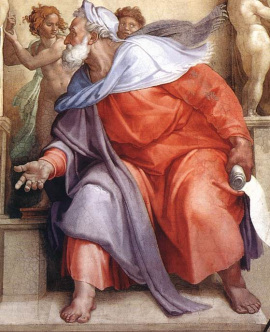Scripture seems to indicate that Ezekiel, a priest, began his life in the ministry at the age of thirty. Several Biblical commentaries state that Buzi, his father, is a descendant of the priestly line of Zadok (Ezekiel 1:1, 3). Zadok was made High Priest at the time of King David (2Samuel 8:17, 15:24 - 29).
Ezekiel, as well as Judah's King Jehoiachin, was taken captive by Babylon's King Nebuchadnezzar during his second attack on Jerusalem in 597 B.C. The Babylonians, after removing Jehoiachin from ruling over the Kingdom of Judah, replaced him with his uncle Zedekiah (he became their "puppet king" - see 2Kings 24 - 25).
The prophet wrote his book from 597 to 570 B.C., which overlapped the ministries of Jeremiah (627 to 585), Daniel (605 to 530) and the Minor Prophets Joel (596 to 586) and Obadiah (590 B.C.). He recorded speaking to God directly at least ninety times, which is the most of any Biblical writer.

A Captive Prophet
God called Ezekiel to be a prophet not only among captive Jews in Babylon, but also to give prophecies concerning all Israel (Ezek. 2:3, 3:4). During the time of his captivity he lived near the river Chebar (1:1, 3:15), which was located near the city of Nippur in Mesopotamia. Although He was married, his wife died during his service to God and he was forbidden to mourn for her.
"Son of man, behold, I take away from you the desire of your eyes with a stroke. Yet neither shall you mourn nor weep, nor shall your tears run down.
"Groan but be silent; make no mourning for the dead . . . " So I spoke to the people in the morning. And in the evening my wife died . . . (Ezek. 24:16 - 18, HBFV throughout).
Noteworthy Prophecies and Events
The prophet was commanded to lay on his left side for 390 days, and then on his right side for 40 days, in front of a mockup of Jerusalem being attacked (Ezekiel 4). This was to signify how long Israel (390 years) and Judah (40 years) were to suffer for their many sins.
God, after many warnings regarding Judah's sins and her need to repent, allowed Babylon's King Nebuchadnezzar to lay a third and final siege to its capital of Jerusalem (the other two occurred in 605 and 597 B.C.). This event was so noteworthy that the Eternal directly informed Ezekiel, who resided a significant distance away from the attack, when the final siege began.
And in the ninth year, in the tenth month, on the tenth day of the month, the Word of the Lord came to me, saying, "Son of man (another name for Ezekiel), write for yourself the name of the day, even of this same day; for the king of Babylon has set himself against Jerusalem this same day" (Ezek. 24:1 - 2, see also 2Kings 25:1)
The date mentioned above regarding when the siege began occurred in 588 B.C. (The Mysterious Numbers of the Hebrew Kings, page 189). Nebuchadnezzar then spent months building forts and trenches around the city in order to starve the people and weaken the capital.
The total destruction of Jerusalem's temple began on Ab 9 in the civil year 3175 (Hebrew Calendar), which corresponds to Tuesday, July 17 in 586 B.C. It would also be on Ab 9, many years later in 70 A.D., that the Romans would begin to destroy the temple that was rebuilt by Herod the Great.
In payment for his long and costly siege of Tyre, the prophet foretold that God would give Nebuchadnezzar the land of Egypt (Ezekiel 29:17 - 20). The prophet predicted that God himself (an allusion to Christ) will seek out his "lost sheep" and bring them back to Israel where he will take care of their every need (34:11 - 31).
Ezekiel also foretold, in his well-known valley of dry bones vision, that God will someday bring back to life and offer salvation to all those humans throughout history who never fully understood his truth (chapter 37). He will also unite the kingdoms of Judah and Israel into one people (chapters 16 - 22).
Ezekiel the prophet reveals the most complete description of Cherubim and what God's millennial temple will look like than any other writer (see Ezek. 1:5 - 24 and chapters 41 to 44). He also predicted that our great adversary, the devil, will someday be judged and have his life taken away due to his rebellion (28:12 - 19).